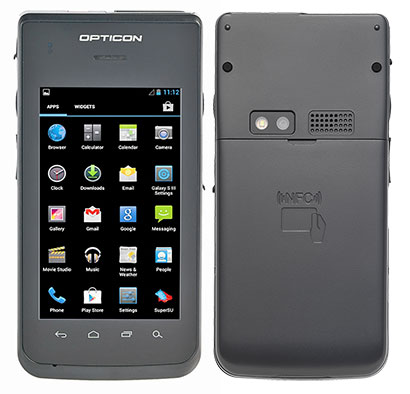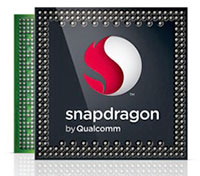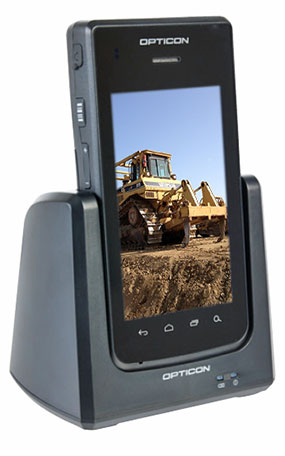|
Opticon H27
Powerful, rugged 4.3-inch Android enterprise terminal for data collection and communication
(by Conrad H. Blickenstorfer)
The Opticon H27 was introduced in August 2014 as a powerful Android based barcode scanner and enterprise terminal for applications such as field sales and service, postal, retail settings, healthcare and similar. It's a ruggedized handheld with an integrated industrial-grade 1D barcode scanner or 2D imager, but one that's slimmer and lighter than an industrial device while being significantly tougher than any consumer smartphone.

The hardware is based on the Qualcomm Snapdragon MSM8960 with dual 1.5GHz ARMv7 Krait cores and an integrated Adreno 225 GPU, a chip used in numerous high-end smartphones.  There's 1GB of DDR2 RAM and 8GB of Flash, and storage is expandable by up to 32GB via a user-accessible microSDHC card slot. Perhaps a sign of the changing times, the software is based not on Windows Mobile as in prior Opticon handhelds, but on Android 4.2.2. There's 1GB of DDR2 RAM and 8GB of Flash, and storage is expandable by up to 32GB via a user-accessible microSDHC card slot. Perhaps a sign of the changing times, the software is based not on Windows Mobile as in prior Opticon handhelds, but on Android 4.2.2.
The H27 measures 3 x 5.8 inches, a footprint no larger than that of today's rapidly growing smartphones. The device is three quarters of an inch thick — very thin for a rugged device. The H27 weighs 8.5 ounces, about twice that of a consumer smartphone, but still quite light. The display measures 4.3 inches diagonally and has full 800 x 480 pixel SVGA resolution. It uses capacitive multi-touch, as is to be expected for a modern handheld with Android. Since this is a rugged professional device, the display is a bit brighter than that of a standard smartphone (350 nits). The display uses the tough Gorilla glass v2, and there's anti-reflective coating for better viewability outdoors.
 Since one of the H27's major intended tasks is data capture device, it's available with either an integrated 1D diode laser scanner or 1D/2D imager with green aiming LED, an NFC reader, GPS and GLONASS for rapid positioning, and there's also a 5mp rear-facing auto-focus camera with flash illuminator for documenting. Since one of the H27's major intended tasks is data capture device, it's available with either an integrated 1D diode laser scanner or 1D/2D imager with green aiming LED, an NFC reader, GPS and GLONASS for rapid positioning, and there's also a 5mp rear-facing auto-focus camera with flash illuminator for documenting.
For communication, there's dual-band 802.11b/g/n WiFi, Bluetooth 4.0, and GPRS/EDGE as well as 3.5G UMTS HSPA+ WWAN. On the wired side there's USB OTG (On The Go). Wired LAN is available via a USB-to_Ethernet adapter cable.
The Opticon H27 also has impressive ruggedness specs. There's a very wide operating temperature range (14 to 122 degrees Fahrenheit), it survives five feet drops onto concrete, and it's sealed to IP65 specifications where the "6" means it's totally dust-proof, and the "5" that it can handle low-pressure water jets from all directions (albeit with limited ingress permitted, which we never like to see).
We haven't had hands on with the Opticon H27 (yet?), but it seems a well conceived, well executed modern handheld with a bright high-res display large enough for real work on the job, a case tough enough to handle drops and rain and heat and cold, industrial grade scanning and data capture technology, and the latest versions of wireless communication. For anyone familiar with the Kyocera Torque, the Opticon H27 has roughly the same specs, but is even tougher and more businesslike.
There are, however, some question marks. While Android is absolutely dominating consumer phones, vertical markets have stubbornly held onto Windows Mobile, meaning the Android platform is still new to industrial market software developers. A pen would be desirable for many applications on a handheld display, be it of the Wacom variety as Samsung uses in their Galaxy Note, or a passive one like on Panasonic's amazing Toughpad M1 that has a capacitive pen tip no thicker than that of a resistive stylus (see our "Advances in capacitive touch and passive capacitive pens"). And the price, while not unreasonable, will seem high to those used to (contract-subsidized) rock-bottom consumer smartphone prices.
Opticon is a worldwide supplier of automatic identification and data collection equipment. The company, which is based in the Netherlands and has been around for over a quarter of a century, was an early manufacturer of barcode scanners and from there branched out into a large variety of data collection modules and devices, as well as ruggedized handhelds such as the H27 described on this page. Opticon has a sales office in Renton, WA.
|
|
|
 Specifications Opticon H27 Specifications Opticon H27
|
|
Added/updated
|
Added 08/2014
|
|
Form-factor
|
Android enterprise terminal
|
CPU/Speed
|
Qualcomm Snapdragon S4 MSM8960 with dual 1.5GHz Krait CPU cores
|
OS
|
Android 4.2.2
|
RAM/ROM
|
1GB DDR2 SDRAM/8GB EMMC
|
Card slots
|
1 user-accessible microSDHC (up to 32GB)
|
Display type
|
TFT LCD, 350 nits, with Gorilla glass v2 and anti-reflective coating
|
Display size/res
|
4.3-inch/800 x 480 pixel
|
Digitizer/pens
|
Capacitive multi-touch
|
Keyboard/keys
|
Onscreen
|
Navigation
|
Touch
|
Housing
|
Unknown
|
Operating Temp
|
14° to 122°F (-10° to 50°C)
|
Sealing
|
IP65
|
Shock
|
5 feet drop to concrete
|
Size (WxHxD)
|
5.8 x 3.0 x 0.75 (147 x 77 x 19 mm)
|
Weight
|
8.5 oz. (245 grams) with battery
|
Power
|
3.7V/2,860mAH/10.6whr Li-Ion ("8 hours"); 80mAh backup for main battery hotswap
|
Interface
|
micro USB OTG, 3.5mm audio, dock
|
Camera
|
5 megapixels, auto-focus, LED flash
|
Sensors
|
Accelerometer, magnetometer, gyro, photometer, proximity
|
Wireless
|
802.11 a/b/g/n/ac, Bluetooth 4.0, NFC, GPS/GLOnASS, GPRS/EDGE, 3G/3.5G UMTS, HSPA+
|
Scanning
|
1D 650 nm visible laser diode or 2D aiming laser diode, illumination LEDs; optional RFID
|
Regulatory
|
CE, FCC, PTCRB, GCF, RoHS, CTIA/IEEE1725, IEC 60825-1 Class 2
|
List price
|
Est. US$1,600
|
Product page
|
Opticon H27 page
|
Product brochure
|
Opticon H27 brochure (PDF)
|
Contact
|
www.opticon.com
|
|
 Opticon H27 Opticon H27
|

|
|



